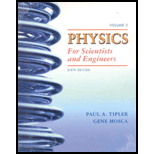
Concept explainers
(a)
The fundamental frequency of the string.
(a)
Explanation of Solution
Given:
Linear mass density of the string is
Tension in the string is
One of the resonance frequency is
Other higher resonance frequency is
Formula used:
Write expression for
Here,
Rearrange above expression for
Write expression for
Here,
Substitute
Calculation:
Substitute
Conclusion:
Thus, fundamental frequency of the string is
(b)
The harmonic which has given frequencies.
(b)
Explanation of Solution
Given:
Linear mass density of the string is
Tension in the string is
One of the resonance frequency is
Other higher resonance frequency is
Formula used:
Write expression for
Here,
Rearrange above expression for
Write expression for
Here,
Substitute
Calculation:
Substitute
Substitute
Conclusion:
Thus, fifth harmonic has the given frequencies.
(c)
The length of the string.
(c)
Explanation of Solution
Given:
Linear mass density of the string is
Tension in the string is
One of the resonance frequency is
Other higher resonance frequency is
Formula used:
Write expression for
Here,
Rearrange above expression for
Write expression for
Here,
Substitute
Write expression for length of the string.
Here,
Calculation:
Substitute
Substitute
Conclusion:
Thus, the length of the string is
Want to see more full solutions like this?
Chapter 16 Solutions
Physics for Scientists and Engineers, Vol. 3
- A string with a mass of 0.30 kg has a length of 4.00 m. If the tension in the string is 50.00 N, and a sinusoidal wave with an amplitude of 2.00 cm is induced on the string, what must the frequency be for an average power of 100.00 W?arrow_forwardA taut rope has a mass of 0.180 kg and a length of 3.60 m. What power must be supplied to the rope so as to generate sinusoidal waves having an amplitude of 0.100 m and a wavelength of 0.500 m and traveling with a speed of 30.0 m/s?arrow_forwardTwo sinusoidal waves are moving through a medium in the same direction, both having amplitudes of 3.00 cm, a wavelength of 5.20 m, and a period of 6.52 s, but one has a phase shift of an angle . What is the phase shift if the resultant wave has an amplitude of 5.00 cm? [Hint: Use the trig identity sinu+sinv=2sin(u+v2)cos(uv2)arrow_forward
- A steel wire of length 30.0 m and a copper wire of length 20.0 m, both with 1.00-mm diameters, are connected end to end and stretched to a tension of 150 N. During what time interval will a transverse wave travel the entire length of the two wires?arrow_forwardA person is playing a small flute 10.75 cm long, open at one end and closed at the other, near a taut string having a fundamental frequency of 600.0 Hz. If the speed of sound is 344.0 m/s, for which harmonics of the flute will the string resonate? In each case, which harmonic of the string is in resonance?arrow_forwardA tube, closed at one end and open at the other, vibrates at room temperature of 20 Celsius with a fundamental frequency of 125 Hz. Which of the following frequencies cannot be a higher harmonic of this system? a. 635Hz b. 750Hz c. 1375Hz d. 375Hz e. 875Hzarrow_forward
- A stretched string is observed to have four equal segments in a standing wave driven at a frequency of 480 Hz. What driving frequency will set up a standing wave with five equal segments? 360 Hz 600 Hz 720 Hz 240 Hz A violin string of length 0.54 m and wave speed of 565 m/s along it. Calculate the frequency of the 5th harmonic. 3138.89 Hz 1046.3 Hz 282.5 Hz 1546 Hzarrow_forwardA steel wire with mass 25.4 g and length 1.30 m is strung on a bass so that the distance from the nut to the bridge is 1.10 m. (a) Compute the linear density of the string._______ kg/m(b) What velocity wave on the string will produce the desired fundamental frequency of the E1 string, 41.2 Hz? ________m/s(c) Calculate the tension required to obtain the proper frequency. ________N(d) Calculate the wavelength of the string's vibration. ________m(e) What is the wavelength of the sound produced in air? (Assume the speed of sound in air is 343 m/s.) _________marrow_forwardOne string of a certain musical instrument is 74.0 cm long and has a mass of 8.76 g. It is being played in a room where the speed of sound is 344 m/s. To what tension must you adjust the string so that, when vibrating in its second overtone, it produces sound of wavelength 0.760 m ? (Assume that the breaking stress of the wire is very large and isn’t exceeded.) What frequency sound does this string produce in its fundamental mode of vibration?arrow_forward
 Principles of Physics: A Calculus-Based TextPhysicsISBN:9781133104261Author:Raymond A. Serway, John W. JewettPublisher:Cengage Learning
Principles of Physics: A Calculus-Based TextPhysicsISBN:9781133104261Author:Raymond A. Serway, John W. JewettPublisher:Cengage Learning University Physics Volume 1PhysicsISBN:9781938168277Author:William Moebs, Samuel J. Ling, Jeff SannyPublisher:OpenStax - Rice University
University Physics Volume 1PhysicsISBN:9781938168277Author:William Moebs, Samuel J. Ling, Jeff SannyPublisher:OpenStax - Rice University Physics for Scientists and Engineers: Foundations...PhysicsISBN:9781133939146Author:Katz, Debora M.Publisher:Cengage Learning
Physics for Scientists and Engineers: Foundations...PhysicsISBN:9781133939146Author:Katz, Debora M.Publisher:Cengage Learning Physics for Scientists and Engineers, Technology ...PhysicsISBN:9781305116399Author:Raymond A. Serway, John W. JewettPublisher:Cengage Learning
Physics for Scientists and Engineers, Technology ...PhysicsISBN:9781305116399Author:Raymond A. Serway, John W. JewettPublisher:Cengage Learning



